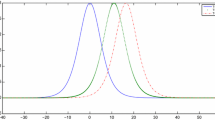Abstract
The properties of various numerical methods for the study of the perturbed sine-Gordon (sG) equation with impulsive forcing are investigated. In particular, finite difference and pseudo-spectral methods for discretizing the equation are considered. Different methods of discretizing the Dirac delta are discussed. Various combinations of these methods are then used to model the soliton–defect interaction. A comprehensive study of convergence of all these combinations is presented. Detailed explanations are provided of various numerical issues that should be carefully considered when the sG equation with impulsive forcing is solved numerically. The properties of each method depend heavily on the specific representation chosen for the Dirac delta—and vice versa. Useful comparisons are provided that can be used for the design of the numerical scheme to study the singularly perturbed sG equation. Some interesting results are found. For example, the Gaussian approximation yields the worst results, while the domain decomposition method yields the best results, for both finite difference and spectral methods. These findings are corroborated by extensive numerical simulations.













Similar content being viewed by others
References
Scott AC, Chu FYF, McLaughlin DW (1973) The soliton: a new concept in applied science. Proc IEEE 61:1443–1483
Ablowitz MJ, Segur H (1981) Solitons and the inverse scattering transform. SIAM, Philadelphia
Fei Z (1992) Y S Kivshar and L Vázquez, Resonant kink–impurity interaction in the sine-Gordon model. Phys Rev A 45:6019–6030
Forinash K, Peyrard M, Malomed BA (1994) Interaction of discrete breathers with impurity modes. Phys Rev E 49:3400–3411
Cao XD, Malomed BA (1995) Soliton-defect collisions in the nonlinear Schrödinger equation. Phys Lett A 206:177–182
Ernst T, Brand J (2010) Resonant trapping in the transport of a matter-wave soliton through a quantum well. Phys Rev A 81(033614):1–11
Goodman RH, Holmes PJ, Weinstein MI (2002) Interaction of sine-Gordon kinks with defects: phase space transport in a two-mode model. Physica D 161:21–44
Goodman RH, Slusher RE, Weinstein MI (2002) Stopping light on a defect. J Opt Soc Am B 19:1635–1652
Goodman RH, Haberman R (2004) Interaction of sine-Gordon kinks with defects: the two-bounce resonance. Physica D 195:303–323
Goodman RH, Haberman R (2007) Chaotic scattering and the \(n\)-bounce resonance in solitary–wave interactions. Phys Rev Lett 98(104103):1–4
Fratalocchi A, Assanto G (2007) Symmetry-breaking instabilities in perturbed optical lattices: nonlinear nonreciprocity and macroscopic self-trapping. Phys Rev A 75(063828):1–5
Mak WCK, Malomed BA, Chu PL (2003) Interaction of a soliton with a local defect in a Bragg grating. J Opt Soc Am B 20:725–735
Morales-Molina L, Vicencio RA (2006) Trapping of discrete solitons by defects in nonlinear waveguides arrays. Opt Lett 31:966–968
Pando CL, Doedel EJ (2005) Onset of chaotic symbolic synchronization between population inversions in an array of weakly coupled Bose–Einstein condensates. Phys Rev E 71(5 Pt 2): 056201
Peyrard M, Kruskal MD (1984) Kink dynamics in the highly discrete sine-Gordon system. Physica D 14:88–102
Piette B, Zakrzewski WJ (2007) Scattering of sine-Gordon kinks on potential wells. J Phys A 40(5995):1–16
Soffer A, Weinstein MI (2005) Theory of nonlinear dispersive waves and selection of the ground state. Phys Rev Lett 95(213905):1–4
Trombettoni A (2003) Discrete nonlinear Schrödinger equation with defects. Phys Rev E 67(016607):1–11
Friedlander FG, Joshi MS (1998) Introduction to the theory of distributions. Cambridge University Press, Cambridge
Ablowitz MJ, Herbst BM, Schober CM (1995) Numerical simulation of quasi-periodic solutions of the sine-Gordon equation. Phycica D 87:37–47
Jung J-H, Don WS (2009) Collocation methods for hyperbolic partial differential equations with singular sources. Adv Appl Math Mech 1:769–780
Boyd JP (2001) Chebyshev and Fourier spectral methods. Dover, New York
B Fornberg (1998) A practical guide to pseudospectral methods. Cambridge Universiy Press, Cambridge
Gottlieb D (1977) Numerical analysis of spectral methods: theory and applications. SIAM, Philadelphia
Hesthaven JS, Gottlieb S, Gottlieb D (2007) Spectral methods for time-dependent problems. Cambridge Universiy Press, Cambridge
Trefethen LN (2000) Spectral methods in Matlab. SIAM, Philadelphia
Chakraborty D, Jung J-H (2013) Efficient determination of the critical parameters and the statistical quantities for Klein–Gordon and sine-Gordon equations with a singular potential using generalized polynomial chaos methods. J Comput Sci 4:46–61
Chakraborty D, Jung J-H, Lorin E (2013) Efficient determination of critical parameters of nonlinear Schrödinger equation with point-like potential using generalized polynomial chaos methods. App Numer Math 72:115–130
Faddeev LD, Takhtajan LA (1987) Hamiltonian methods in the theory of solitons. Springer, New York
Acknowledgments
We thank Roy Goodman, Panayotis Kevrekidis, and Jingbo Xia for many valuable discussions. This study was partially supported by the National Science Foundation under Award Number DMS-0908399.
Author information
Authors and Affiliations
Corresponding author
Rights and permissions
About this article
Cite this article
Wang, D., Jung, JH. & Biondini, G. Detailed comparison of numerical methods for the perturbed sine-Gordon equation with impulsive forcing. J Eng Math 87, 167–186 (2014). https://doi.org/10.1007/s10665-013-9678-x
Received:
Accepted:
Published:
Issue Date:
DOI: https://doi.org/10.1007/s10665-013-9678-x




